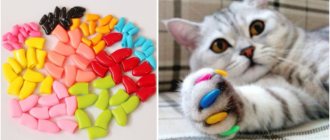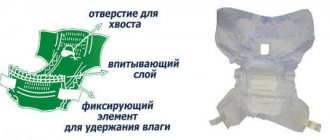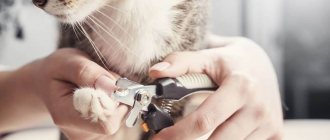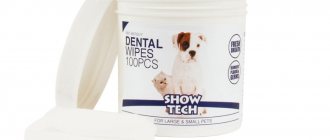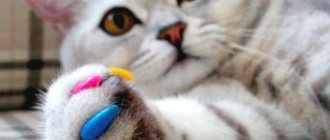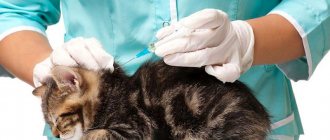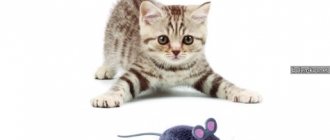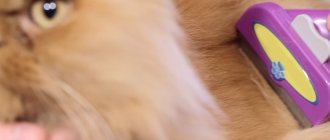Every owner, when a kitten appears, worries about the integrity of his furniture, wallpaper, and curtains. In addition, kittens often lose their claws, clinging to carpeting. To protect the cat from damage to its claws and prevent dirt and germs from getting under them, they came up with the idea of gluing the cat’s nails, thereby eliminating problems.
Advantages and disadvantages
Positive aspects of using anti-scratch for cats:
- Safety of household goods.
- Avoid scratching the skin when the animal is sick.
- Facilitation of hygienic and medical procedures.
- Self-sticking and removal.
- Availability of material.
But it is worth considering the disadvantages of this procedure:
- The cat will not be able to fully clean its fur and ears.
- Chewed off plastic caps can be swallowed by a cat.
- If the animal ends up on the street, it will not be able to run away from the enemy into a tree or fight back.
- You can also forget about catching mice.
View this post on Instagram
Posted by Marina Grumer (@marinagrumer) Aug 15, 2022 at 12:00 pm PDT
Anti-scratch vs surgery, scratching post and trimming
In addition to protective kits, the pet store also offers other means designed to save your home from destruction: sprays, special pheromones, which, alas, do not always work.
Another effective, but completely unacceptable for any pet, method is onychectomy - surgical removal of the claw and part of the finger. This is a very dangerous procedure that leads to dire consequences. The cat becomes disabled and cannot lead a full life and take care of itself. Many animals lose their mental health after onychectomy, which is why the operation is prohibited by law in some countries.
A scratching post becomes a solution if the cat has been trained to use it. In other cases, it simply does not work - or the pet uses both the scratching post and the owner’s favorite chair.
Trimming nails is only partially effective. Claws grow quickly, and they sharpen even faster. They have to be trimmed with a nail file all the time, and this takes a long time. Not every cat will sit for 10 minutes and endure the unpleasant procedure.
Therefore, protective kits become the best alternative. They can be used regularly, or for a short period of time - for example, during a trip, a long stay with relatives with small children, or a visit to the veterinarian.
Is there any harm to cats?
The pads do not cause any harm to humans; on the contrary, they relieve scratches and inflammatory processes.
A cat's natural claws will not be damaged if you choose the right size of anti-scratch claws. At the same time, the coatings are preserved without damage.
But not all cats are the same in character. Some people will not like this version of the problem, and until they get rid of plastic masks, they will not calm down. Gnawing on the pads can damage the teeth and there is a risk of swallowing the tip. But it is made from animal material that is safe for the body and has a smooth shape, so when it enters the body, the tip will calmly pass through the esophagus and come out without causing harm.
How often do you need to change the pads?
You should not remove the caps yourself, especially if this is not associated with a threat to health and life. The additional manipulation of removing the tips will cause further stress for the cat. Objective factors that require ridding the animal of protective kits are:
- allergic reaction;
- improper gluing;
- prolonged nervousness.
It is important to understand that this is not only decoration. They cannot be changed when the owner is tired of the appearance. A person’s whim is not a reason to subject an animal to an unnecessary procedure.
When not to use anti-scratch products
It is not always appropriate to use overlays. This is in such cases:
- The kitten is not yet six months old; it has soft small claws that wear off on their own during play.
- Older cats: an older animal does not show much interest in games or household items.
- Animal intolerance to artificial materials from which the product is made.
- If the cat is characteristic, he does not like innovations on himself.
- When a cat is outside, it will not be able to protect itself.
Useful video on the topic:
What are silicone claw pads (anti-scratch)
Anti-scratch pads are cap-shaped covers for animal claws. The caps are made of soft, flexible silicone. The linings are also called “soft claws”. They are placed over cats' clipped claws to protect them from scratching.
anti-scratch is a device for protection against scratching
Anti-scratch pads were invented by veterinarian Toby Wexler (USA). This discovery became an alternative to onychectomy (declaw removal), as painful removal was considered the most inhumane way to protect against scratching. In civilized countries, onychectomy is prohibited, so anti-scratch treatments quickly became popular throughout the world. They come in different sizes, so they are suitable for cats aged four months and older. In addition, caps are now sold in different colors. However, anti-scratch pads are not just a fashionable device; sometimes purchasing such pads is vital. It is recommended to purchase claw pads in the following cases:
- if the animal is aggressive and rushes at guests;
- if the cat is overly playful and therefore violently attacks family members;
- if the cat is jealous and cannot come to terms with the appearance of another pet in the house (trying to “revenge” it);
- if there are small children in the house;
- if your pet has health problems (for example, with atopic dermatitis, the cat itches, scratching the skin until it bleeds).
Rating of nail overlays and price comparison
In zoological stores you can buy anti-scratch products from the following brands:
- Soft Paws Nail Caps. Country of manufacture: USA. The kit includes a special glue that does not affect the animal’s body. The package may contain products of the same tone or different, there are 40 pieces in total, the package also contains 2 tubes of glue. The average wearing time is 4–6 months. Produced in all sizes.
- Soft claws from Cliny. Presented in one version - silicone in a silver shade. Non-toxic. Comfortable to wear and does not cause discomfort to the animal.
- Crazy Liberty - domestic manufacturers produce soft products in different, bright colors. The package contains 20 pieces and 1 tube of glue.
- Barbos is also domestically produced. There are 40 pieces in the package, one large tube of glue. Anti-scratch pads are multi-colored, there is a transparent option.
The price depends on the manufacturer, the material being made, and the number of anti-scratch pads in the package. On average it is 100–250 rubles.
Rules for using anti-scratch pads
Before you start working with anti-scratch products, you need to carefully study the instructions
The package can include up to 40 pads, glue and instructions. Before starting work, you should carefully study the operating instructions. If you stick the caps only on the front legs, the package will be enough for 4 times. The pads stay on the claws for up to 8 weeks. If the cat does not take them off earlier, and you put them on strictly according to the instructions, then the packaging will last for several months (up to six months) . If you make a mistake with the size, the caps can be changed at the seller or trimmed. At the time of fitting it will become clear whether there is such a need.
When not to cap cats' claws
Anti-scratch guards are intended for domestic cats. That is, for those animals that do not end up on the street. Firstly, the owner cannot always keep track of the cat if it goes out. And there are many dangers on the street (for example, claw injury). Secondly, the animal must be able to climb to some height (if necessary).
Anti-scratch guards should also not be placed on the claws of pets prone to allergies (the cat may not tolerate glue). The original packaging comes with good quality glue, so the risk of allergies is low. But no one can guarantee the quality of the glue that comes with cheap fakes.
It is not advisable to stick caps on the claws of a sick cat
If your pet is sick, it is better not to irritate him with innovations. A weakened animal may not resist, but due to an unexpected “manicure” the cat may become stressed. This may make the condition worse.
How to glue cat claw caps
Before gluing the pads, you need to organize a fitting (without glue) on already trimmed nails. There is no need to trim the nails completely. It is enough to cut off the sharp corner of the claw and also treat it with a nail file on all sides. After this, the claws are degreased, for example, with alcohol (you can use acetone, but the cat may not like the pungent smell). This is necessary for better adhesion to the glue. The cap should not slip off, and its edges should be at a distance of 3–5 millimeters from the base of the claw. If this indentation is not a balloon, then the overlay can be shortened using scissors. After trying on all the caps, you can begin gluing. You need to work with glue very carefully. If there is too much of it, a drop of glue will fall on the cat's fingers, and it will hurt the cat when it moves. You can follow the following plan:
- Calm the cat (you can pet it or give it a treat) so that it is not afraid.
- Place a small amount of glue inside the cap.
- Take the cap in your right hand, and lightly press on the paw with your left so that the animal releases its claws.
- Place the cap on the desired claw (without releasing your left hand).
- Make sure that the glue does not get on the skin near the claw.
- Wait a while (5 minutes) until the glue dries.
If there is still a lot of glue, you need to wipe off the excess with a napkin. This must be done quickly so that the glue does not have time to dry. After gluing all the caps, the cat will try to rip them off, so you need to distract the cat (with food or a toy) for some time after the procedure.
How to glue correctly
The gluing process should not bring any inconvenience or stressful situations to the animal. Step-by-step gluing of anti-scratch protection:
- The animal must be prepared: feed it, sit it in your arms, talk calmly, pet it.
There should be no extraneous sounds in the room that distract or irritate the animal.
- You need to take the cat's paw, press lightly so that claws appear (this process is similar to the procedure with circumcision).
- Before gluing the anti-scratch pads, measure the claws to ensure they fit perfectly.
- A little glue is poured into the pad, after spreading, glue it onto the claw, press down a little.
The animal is not immediately released. We must wait until all the tips have completely hardened.
To extend the life of the pads, you can trim the claws by 1–2 mm, no more.
We recommend videos on the topic:
Duration of use
Protective accessories fall off the paws on their own as the nail plate grows. Therefore, their service life is related to the health, lifestyle and behavior of the cat. On average, the period of wearing the kit lasts from 2 to 4 weeks, and sometimes reaches 2 months.
In some cases they may be lost. The eared friend leaves them in the long pile of the carpet or chews them off.
What do veterinarians say?
There are no clear reviews among veterinarians about anti-scratch products for cats. But most doctors tend to recommend them for their mustachioed patients.
Common Myths
Despite the fact that manufacturers insist that silicone claws are completely safe for the health of your mustachioed friend, there are quite a lot of myths about their use. Here are the most common reasons why owners do not want to purchase the “soft paws” accessory:
- The claws itch underneath. This is incorrect because there are no nerve endings on the nail plate.
- They interfere with retracting the claws. In fact, everything is attached to the tip, which sticks out of the pad.
- The animal's gait changes greatly. This is true, but not for all cats and for a very short period of time.
- The material and glue are toxic. Manufacturers and veterinarians say this is not true. Even ingestion cannot harm your pet.
To make use as comfortable as possible, it is necessary to follow the order of gluing them. In addition, when choosing silicone kits at a pet store, it is important to carefully read their composition and instructions.
